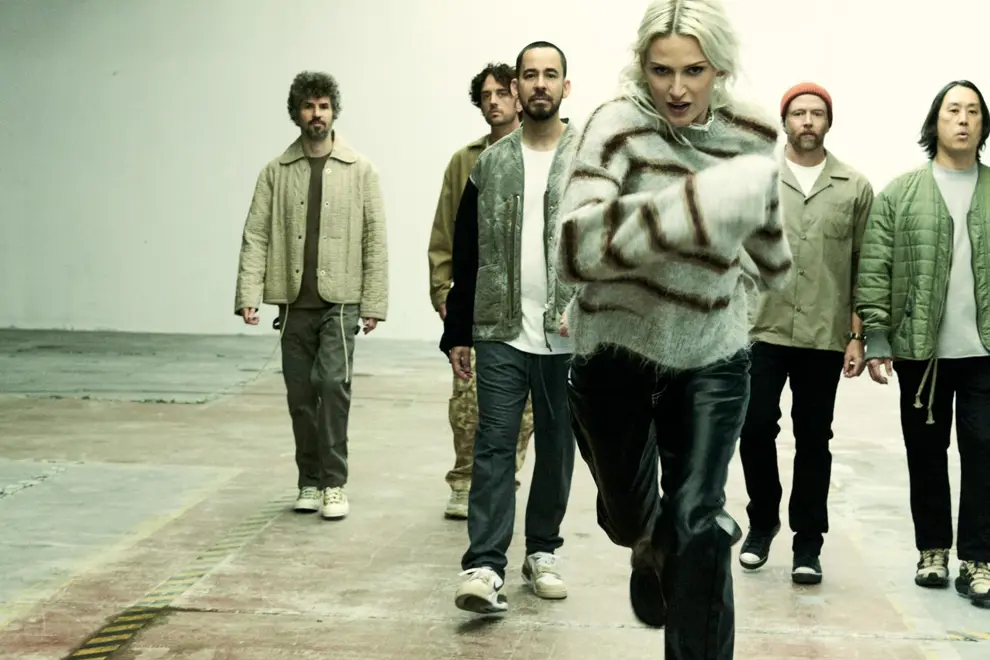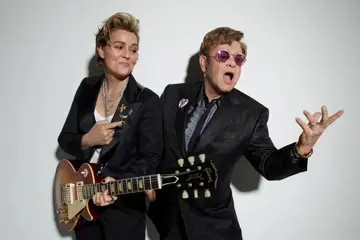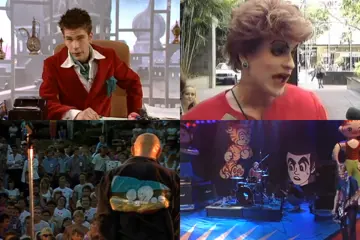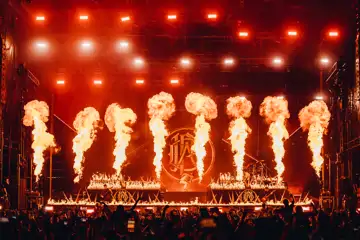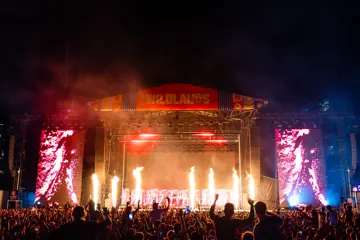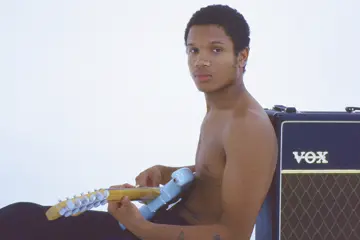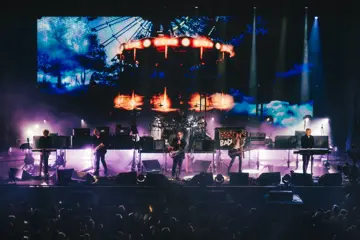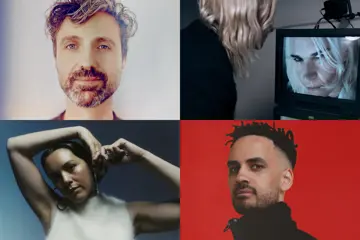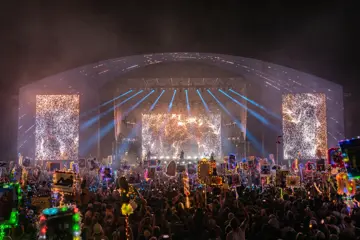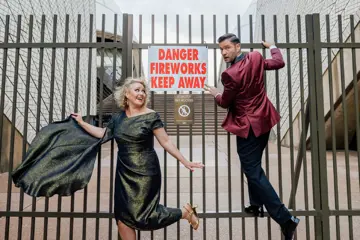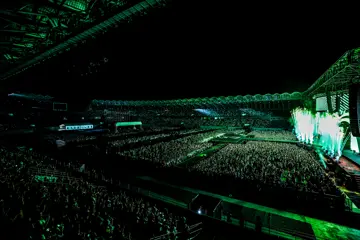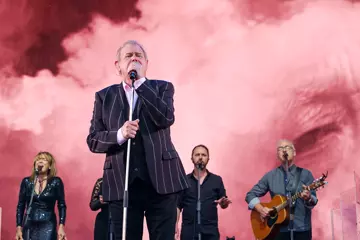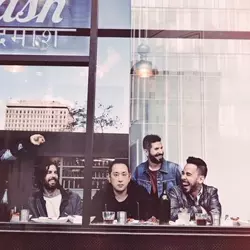 Linkin Park
Linkin ParkLinkin Park will tour Australia in March 2026. The last time they were here was for Soundwave 2013, and it’s fair to say a lot has happened since then.
Following the tragic passing of the band’s original lead vocalist, Chester Bennington, in 2017, for a long time it seemed like that would be the end for Linkin Park. But last year they returned, introducing new lead vocalist Emily Armstrong and drummer Colin Brittain. Singer, rapper, producer and guitarist Mike Shinoda has always been the band’s de facto leader, and that remains the case nearly 30 years into their career.
In anticipation of Linkin Park’s 2026 Australian arena shows, here’s a look at the band’s ten greatest moments.
Emily Armstrong joins, The Emptiness Machine is released
Speaking at BIGSOUND in 2023, Shinoda made it seem like Linkin Park had no plans for a post-Bennington record.
“We don’t talk about that stuff,” he said. “It’s not the plan right now.” But Shinoda was equivocating. As it turns out, Linkin Park had begun working on new music in 2019 – bassist Dave “Phoenix” Farrell said so in a livestreamed chat with Dan Nicholl of Dan Really Likes Wine in 2020.
2019 was also the year that Shinoda and co. met vocalist Emily Armstrong of hard rock band Dead Sara. But they didn’t officially ask her to join until 2023. Original drummer Rob Bourdon declined to be part of the reunion, which meant Colin Brittain was also welcomed into the fold.
Don't miss a beat with our FREE daily newsletter
After much speculation, Linkin Park announced their comeback on 5 September 2024. The Emptiness Machine was the first single of the band’s new era – a melodic alternative rock song that didn’t reinvent the wheel, but reminded Linkin Park fans of what they loved about the band, and showcased Armstrong’s immense vocal power.
One Step Closer
Linkin Park’s debut single, One Step Closer, came out in August 2000. The angsty nu metal song has become synonymous with the band’s early era, but it underwent a series of significant revisions before seeing the light of day.
It was originally titled Plaster, but Don Gilmore, the producer of Linkin Park’s debut album, Hybrid Theory, thought it needed work. He especially pressed Bennington to update and improve his lyrics. Bennington channelled his frustration with Gilmore’s interventions straight back into the lyrics.
“Everything you say to me,” Bennington sings in the song’s now-iconic chorus. “Takes me one step closer to the edge / And I'm about to break.”
Making Collision Course with Jay-Z
Jay-Z announced his retirement from music in November 2003. It did not eventuate: within a few months, the rapper and businessperson was sending files back and forth with Shinoda for a proposed mash-up record. The six-track EP, Collision Course, materialised 12 months after Jay-Z’s botched retirement.
The origins of Collision Course are in Danger Mouse's The Grey Album, which merged Jay-Z’s The Black Album with The Beatles’ self-titled (also known as The White Album). After hearing the record, Jay-Z wanted to take matters into his own hands, so he contacted Shinoda about a collaboration. A few days later, Shinoda sent back three demos that placed Jay’s voice over Linkin Park instrumentals.
As the project developed, they decided to re-record a lot of the music and lyrics, making Collision Course more of a unique collaboration than a DJ-style mash-up. The record’s one single, a combo of Linkin Park’s Numb and Jay-Z’s Encore, was a multi-platinum hit around the world and won the Grammy for Best Rap/Sung Collaboration.
In the End at Live 8
Linkin Park performed a four-song set at Live 8 in Philadelphia's Benjamin Franklin Parkway in July 2005. They were then joined by Jay-Z for a fifteen-minute run-through of Collision Course cuts. But they’d already peaked – specifically with In the End, the fourth single from Hybrid Theory, and the biggest hit of the band’s career.
“If you know it, then you need to help us out,” Shinoda said at the start of the song. “You sing along with Chester, all right?” The crowd, estimated to number more than half a million people, acquiesced, and Shinoda got them all clapping in time during the bridge.
Numb at Madison Square Garden in 2011
Numb is second only to In the End in terms of overall popularity, but it’s the more overt pop song of the pair. The song’s indebtedness to 80s synth-pop acts like Depeche Mode and Pet Shop Boys is made explicit in this live performance from New York’s Madison Square Garden during the band’s A Thousand Suns tour in 2011.
But while the sentimental verses and hooky keyboard licks have a touch of the new romantic about them, the chorus is all Bennington, his pain made palpable by the way he strains to reach the high notes.
What I’ve Done
Founding member Joe Hahn is not just Linkin Park’s turntablist, but also the band’s creative director. He’s collaborated with Shinoda on album artwork and directed the music videos for Numb, Pts.OF.Athrty, Somewhere I Belong, and What I’ve Done. Hahn also played a pivotal role in the thematic development of the latter, which was the first single from 2007’s Minutes to Midnight.
Linkin Park ditched the heavily layered nu metal sound on their third album, replacing it with a rawer alt-rock sound. Hahn suggested that Shinoda and Bennington write a song summarising the stylistic shift, and What I’ve Done was the result.
“In a way, it's us saying goodbye to how we used to be,” Bennington said of the song. “The lyrics in the first verse are, ‘In this farewell / There's no blood / There's no alibi,’ and right away, you'll notice that the band sounds different.”
Electronics and politics on Minutes to Midnight, A Thousand Suns, Living Things
Two albums into their career, Linkin Park were one of the biggest bands in the world. Their debut, 2000’s Hybrid Theory, went 12-times platinum in the US, while their second LP, 2003’s Meteora, debuted at number one in the US, UK and all over Europe.
But they weren’t interested in churning out more of the same. Their third album, Minutes to Midnight, marked the beginning of a creatively adventurous collaboration with producer Rick Rubin, known for his work with the Beastie Boys, Slayer, Johnny Cash and Jay-Z. Kanye West once said that Rubin is “not a producer, he's a reducer," and this was evident in the stripped-back alternative rock record sound of Minutes to Midnight.
2010’s A Thousand Suns was an even bolder experiment, an electronic-infused, political-pop record that was compared to Kid A, Dark Side of the Moon and Public Enemy’s Fear of a Black Planet.
The electronic influences remained on 2012’s Living Things, but the band reintroduced heavy guitars and scream-sang vocals, finding a middle ground between their chart-topping early work and their latter-day shape-shifting.
The Hunting Party
After abandoning their hard rock and nu metal roots on their three previous records, Linkin Park returned to riff-heavy rock music on their sixth album, The Hunting Party. The album’s visceral, hard-hitting sound wasn’t just a nostalgia trip – according to Shinoda, it was a reaction against the “very tame” rock music that dominated the airwaves in the first half of the 2010s.
“We got so sick of bands trying to be other bands and playing it safe the whole time,” he told Kerrang. “[There are] a lot of radio jingle songs that sound like they belong on Nickelodeon or Disney.”
They invited some friends and heroes to contribute to the album, including System of a Down’s Daron Malakian, Rage Against the Machine’s Tom Morello and Helmet’s Page Hamilton. Meanwhile, hip hop legend Rakim’s inimitable flow can be heard in the bridge of the album’s lead single Guilty All the Same.
Linkin Park and Friends: Celebrate Life in Honor of Chester Bennington
Bennington tragically passed in July 2017 at the age of 41. His death came three months after Linkin Park released their seventh album, One More Light. All upcoming tour dates were cancelled, but the band held a tribute concert for Bennington at the Hollywood Bowl in October 2024.
They were joined by a long list of celebrity guests, including Blink-182, MGK, Steve Aoki, Zedd, Bebe Rexha, and members of Bush, Avenged Sevenfold and A Day to Remember. Highlights included Jonathan Davis of Korn singing One Step Closer, Sum 41’s Deryck Whibley singing The Catalyst, and Oli Sykes of Bring Me the Horizon singing Crawling.
But the most touching performances of the day were instrumental versions of In the End and Numb, with the band letting the crowd perform Bennington’s vocal parts.
From Zero
Before they were called Linkin Park, Shinoda, Farrell, Bourdon, Hahn and guitarist Brad Delson were in a band called Xero. They formed in Los Angeles in 1996 and played their first show supporting System of a Down the following year. But they didn’t gain much traction until Warner Bros. A&R guy Jeff Blue put them in touch with Bennington in 1999.
There’s something very apt about the band’s decision to name their eighth album, and their first with Armstrong, From Zero. But despite the monumental shake-up, they were hardly starting from scratch. Armstrong’s debut with the band was one of the most anticipated moments in recent rock music history.
So, did it deliver? The Guardian’s Alexis Petridis said it best: “It ticks all conceivable boxes a Linkin Park fan might want, without ever sounding like an exercise in box ticking.”
Linkin Park will tour Australia in March 2026. For pre-sale information and ticketing details, head to the Live Nation Australia and LP Underground websites.
Presented by Live Nation and Triple M
LINKIN PARK
FROM ZERO WORLD TOUR - AUSTRALIA 2026
Tuesday 3 March - Brisbane Entertainment Centre, Brisbane
Sunday 8 March - Rod Laver Arena, Melbourne
Saturday 14 March - Qudos Bank Arena, Sydney

